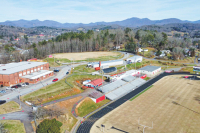Building a bridge of ideas and insight from the Smokies to Iceland
 By George Ivey • Contributing writer
By George Ivey • Contributing writer
What in the world would bring together the Great Smoky Mountains and the country of Iceland way up there in the cold waters of the North Atlantic?
One teems with lush plant and animal life, but also boasts a rich cultural history dating back to the early Cherokee, some of the oldest mountains on earth, black bears and moonshine. The other is socked in by glaciers, but also claims a rich cultural history dating back to the Vikings, volcanoes creating some of the newest land on earth, an occasional polar bear and a drink called Black Death.
Thanks primarily to my Icelandic mother, I have visited Iceland often, and I have marveled at its black sand beaches, countless waterfalls, and bizarre rock formations that lead many Icelanders to believe they have seen trolls. With all its geysers, steam vents, boiling mud and vividly colored geology, the Icelandic landscape in fact appears so different from the rest of Earth that movie directors often choose Iceland to portray other planets.
Beyond these great contrasts, though, Iceland and the Smokies share several common elements, especially their spectacular national parks that protect natural and cultural resources and attract hundreds of thousands of tourists every year.
America of course gave birth to the national park concept back in the 1800s. The Great Smoky Mountains National Park took shape starting in the 1920s. The park then grew with the creation of Fontana Lake in the 1940s, a hydropower dam built to fuel an aluminum factory making airplanes for the WWII effort.
Related Items
More than 70 years later and 3,000 miles away, history more or less repeated itself, when Iceland officially established Vatnajokull National Park in 2008 as the largest national park in Europe (roughly six times the size of the Smokies); similar to Great Smokies, this vast new Icelandic park borders new hydroelectric dams that power a nearby aluminum smelter.
Several years ago, Alcoa — the aluminum factory on the Tennessee side of the Smokies that was powered by Fontana dam’ energy — began to bring these parks together. Specifically, the Smokies had a robust and generous network of park lovers united under the banner of the Friends of the Smokies, a non-profit that raises money to support myriad projects the park could otherwise not afford, from research to trail rehabilitation to fieldtrips for school children.
Iceland, it seemed, could use some insight and help guiding the creation of a similar friends group that would help preserve and protect young Vatnajokull National Park.
I became the point person for the project. It’s indeed a rare moment when seemingly unrelated aspects of your life combine perfectly — namely my previous role as the director of Friends of the Smokies North Carolina office, a consulting business aimed at helping small non-profits, and, or course, being half-Icelandic.
I soon flew to Iceland and visited park rangers and potential park partners all over the country. We met in offices or traveled as we talked. I saw Icelandic reindeer up in the highlands for the first time, and one of my hosts generously took some short detours to show me two of the houses where my mother spent parts of her childhood.
I talked with determined young rangers and older professionals. Just one person thought that he already knew everything; the rest were struggling with many of the same issues we have encountered at American parks: wanting to attract visitors without loving these special places to death, wondering how best to work with local communities, searching for new revenue sources to conserve wildlife and support education, and more.
I offered best practices from American parks and friends groups when I could, and I commiserated when I couldn’t.
Several Icelanders have also come to America, attending a conference on national parks in Texas and visiting Yosemite, the Blue Ridge Parkway, and the Smokies, among others. The Icelanders learned first-hand about Parks as Classrooms and Junior Ranger programs, resource management, the fundraising efforts of Friends of the Smokies, and the visitor center stores run by the Great Smoky Mountains Association.
The Icelanders have repeatedly expressed their thanks and appreciation to all of the American park staff and partners who have guided them, advised them and answered their countless questions.
The learning isn’t only one-way, though, always heading northeast from the Smokies. Teaching is one of the best ways to sit down and capture your own best practices, but the Icelanders bring their own instructive ideas and approaches to the table, such as their great success in attracting international visitors to volunteer for weeks at a time working on trails and other projects. They also utilize a different approach to managing parks, whereby local citizens serve on park management committees.
With renewed support from Alcoa, we are now orchestrating a more formal and intensive training program for staff and partners from a wider group of Iceland’s national parks and natural areas. I’m both thankful and proud to say that U.S. National Park Service staff and other people from Washington, D.C., to Washington State have been quick to help.
The Great Smokies and Vatnajokull are also exploring the possibility of a formal sister park arrangement to continue these exchanges of ideas and information on common interests like tourism, scientific research, climate change and fundraising. For the parks, park rangers, wildlife, and other resources, it’s a budding relationship that holds great promise for the future.
As with almost any international exchange, we may struggle at times with differences of language and culture, like pronouncing Eyjafjallajokull or eating rotten shark, while at other times, we may stand in awe of what others have or have done, like Iceland’s geothermal energy expertise and their thousand-year-old parliament.
We will also find plenty of similarities that allow us to speak a common language, share best practices, and prepare ourselves for great new things. While black bears and polar bears may not mix well together, we are already off to a great start in bringing together the best of the place of blue smoke and the best of the land of fire and ice.









